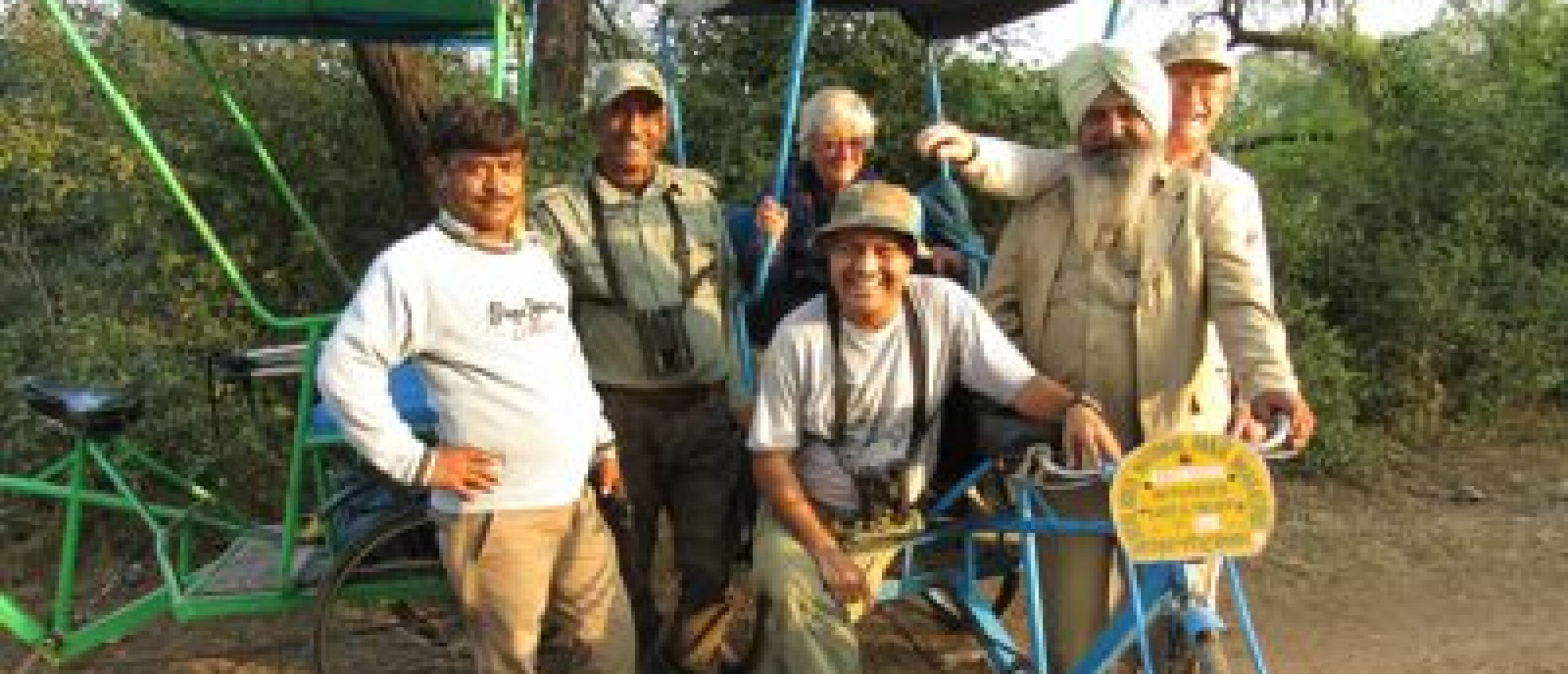
Bharatpur, a hunting reserve come good At the end of our Gujarat trip, Rosemary and I had two sad Goodbyes to endure: Yogi Bisht, of Rural Traveller, who had looked after us so well in Nagzira Tiger Reserve (where he had even entered the kitchen of the filthy canteen and cooked our meals himself!) and throughout our Gujarat trip was due to depart by train that afternoon for Delhi and then home to Ramnagar, and our excellent and trusty driver Bhawani Singh, who had driven us all over Gujarat, showing us the best birding sites of the state (he had also driven for Paul Holt, of the UK bird tour company Sunbird, and knew the birding sites of Gujarat like the back of his hand), was due to drop us off at Ahmedabad airport and then Yogi at the station. Our heartfelt thanks go to both of them; we will certainly meet again, hopefully when I have put together my own tour programme (with the elusive Crab Plover as a key target bird!). Rosemary and I then flew to Jaipur, where we were picked up by our new driver Maharaj Singh, who spirited us to Bharatpur, our home for the coming five nights. We checked into the Birder's Inn, situated close to the entrance of the Keoladeo Ghana National Park, one of India's smallest but ornithologically richest protected areas. Originally set up as a private hunting reserve, Bharatpur hosted some of the largest duck shoots ever recorded, with the maximum daily bag of 4,273 ducks being claimed at a shoot hosted by Lord Linlithgow, then Viceroy of India, in 1938. The Maharaja retained the shooting rights until 1972, when Indira Gandhi's Wildlife Act outlawed all forms of hunting in India (as far as I know, India is the only country that has placed an outright ban on hunting). It is now a World Heritage Site, and Peter Scott once called it the World's best birding area.
 The plaque commemorating Lord Linlithgow's bloodbath
The plaque commemorating Lord Linlithgow's bloodbath
For me, too, this wonderful reserve held a nostalgic significance. I had visited the park in 1988 while on a tour with Ornitholidays, led by Simon Boyes. I was living in Japan at the time, so I had flown in from Tokyo and my parents from London; my father had just retired, and that tour was intended to ease his adjustment to a life of leisure. It led to my parents doing at least one major bird tour per year, either with Ornitholidays or with Sunbird, every year from 1988 to 2009. The most poignant difference I noticed from 1988 was the absence of the most emblematic of Bharatpur's bird species, the stately Siberian Crane. We had witnessed the last family, two parents and one young, that wintered in this park, or anywhere in India. The western population of the Siberian Crane was decimated by hunting, mainly on migration in Afghanistan and Pakistan, and now the species winters only at Lake Poyang in China, where virtually the entire World population of around 3,000 can be found, but they are vulnerable to the as yet unquantified effects of the Three Gorges Dam, which will alter the seasonal flood patterns on which the Siberian Crane and other wintering species depend.
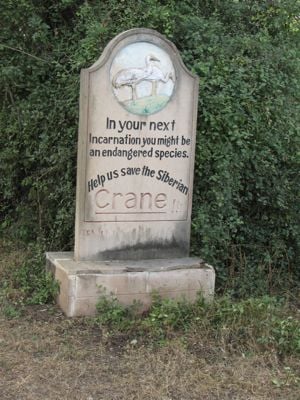 A poignant reminder that came too late for the Siberian Crane
A poignant reminder that came too late for the Siberian Crane
The huge change for Rosemary and myself here compared with the rest of our trip was the means of transport used to get around the protected area. On the Central Indian leg of our journey, we had become used to being bounced around in a Maruti Suzuki Gypsy on very rough tracks; here we were each assigned a cycle rickshaw, Rosemary being driven by the dignified Mr Raju Singh, and myself by Harish, "Mr Snake" (I was later to discover why he had this nickname). Our birding guide was Ikrar Bablu, who rode alongside us on his white bicycle, occasionally darting off to check the presence or absence of some particular bird.
 Rosemary and Sumantha Ghosh with their rickshaw driver Raju Singh
Rosemary and Sumantha Ghosh with their rickshaw driver Raju Singh
Entering the park through the main entrance brought the memories flooding back. The main roadway stretches ahead into the mist, after a while leading into a tunnel of tall trees, beyond which the route is lined on either side by wetlands that teem with birds. In recent years the monsoons have brought less rain than in earlier years, and in some winters the park has been completely dry, a disaster not only for the birds but also for the rickshaw drivers, guides and hotels that depend on the tourists that flock here to see the flocks of birds. Now, however, a system of pumps and a pipeline brings water from the Chambal River (what effect this will have on the river has not yet been ascertained, but there will doubtless be some consequence, as there always is), meaning that the park is adequately supplied with fresh water.
There were so many species of bird, and so many individuals, that it would be hard to list them all here. Most prominent were the larger wading birds including 11 species of heron, 4 of stork (including loud colonies of Painted Storks, whose young have an eerily childlike cry, and the occasional magnificent Black-necked Stork, which one booklet I saw described as "the daddy of them all), 3 species of ibis plus Spoonbill, 3 of cormorant plus Darter, plus 16 species of duck, 4 gallinule and 2 jacana, and 14 of plover and sandpiper.
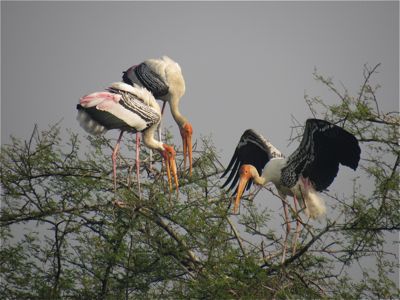 Painted Storks are beautiful but quarrelsome birds at the nest
Painted Storks are beautiful but quarrelsome birds at the nest
 The Black-necked Stork, 'daddy of them all'
The Black-necked Stork, 'daddy of them all'
 The Darter or Snakebird dries its wings like a cormorant
The Darter or Snakebird dries its wings like a cormorant
Owls too were present, although the smaller ones such as Spotted Owlet and Collared Scops Owl usually required a local's knowledge of their regular roosting sites to find them. Much more impressive, however, was the huge Dusky Eagle Owl, of which we saw three individuals.
 The Dusky Eagle Owl is a monstrous bird
The Dusky Eagle Owl is a monstrous bird
Small birds too were not under-represented, with numerous Bluethroats and at least three Siberian Rubythroats hopping out onto the roadways, ten species of warbler seen skulking in the reeds, bushes and trees, three species of shrike perching prominently in search of prey, and three species of kingfisher waiting for their catch of small fish or crickets. It was truly a birdwatcher's bonanza.
 Bluethroats were quite numerous and conspicuous along the tracks
Bluethroats were quite numerous and conspicuous along the tracks
 A Long-tailed Shrike provided outstanding views
A Long-tailed Shrike provided outstanding views
Our daily routine involved entering the park early(ish) in our two rickshaws with Bablu beside us on his bike, and then spending the days in a leisurely (for us, though not for our drivers) way, checking first the wetlands and then the drier forest and scrubland areas, gradually narrowing our search down as the number of target species dwindled, again the sort of birding I love, where rather than becoming bored, one builds up towards a highly focused quest for a few more difficult species.
Bablu seemed to have an uncanny ability to spot the highly elusive Black Bittern, which hides in the darkest recesses under bushes, but his sharp eyes and a knowledge of how and where to look allowed him to show us at least ten of these cryptic birds, which I had only seen the odd individual of on previous Asian birding trips. He and Harish also made a good team in the hunt for the less numerous but equally elusive Yellow Bittern, of which we eventually saw three, Bablu making a long detour around a deep channel, and Harish waiting to spot the bird if Bablu disturbed it.
 An unusually conspicuous Black Bittern
An unusually conspicuous Black Bittern
 Here the Black Bittern seemed to be observing us rather than vice versa
Here the Black Bittern seemed to be observing us rather than vice versa
 The Yellow Bittern was even more elusive than the Black
The Yellow Bittern was even more elusive than the Black
Harish also had extremely sharp eyes, and I came to realise this when my rickshaw suddenly came to a halt, and he pointed out a snake. It took ages for him to explain to me precisely where it was, and in fact it turned out that only a tiny portion of it, its head and a section of its back, were above water. How he spotted it as we were cycling along, I cannot imagine. He informed me that his name, Harish, means snake, which I cannot find any reference to on the internet, but I am willing to believe it given his ability to spot that snake!
 Harish spotted this snake while cycling along
Harish spotted this snake while cycling along
The Siberian Cranes may have been long gone, but at least their even larger cousins the Sarus Cranes were still present, and to see and hear the greeting dance, accompanied by that evocative crane bugling call, as the pair came together after a spell spent foraging separately, was touching to observe. We saw at least three pairs with at least two young, so clearly they are still having some breeding success.
 Sarus Cranes must be among the most elegant of birds
Sarus Cranes must be among the most elegant of birds
Birds were not the only interesting creatures to be seen, and in addition to the considerable numbers of Cheetal (Spotted Deer) and Nilgai antelope, Sambar Deer were also present, as were Jackals and Rhesus Macaques, as well as the ubiquitous Palm Squirrels, one of which even ventured onto Rosemary's lap to feast upon the crumbs she had dropped.
 An atmospheric morning shot of a Cheetal in the mist
An atmospheric morning shot of a Cheetal in the mist
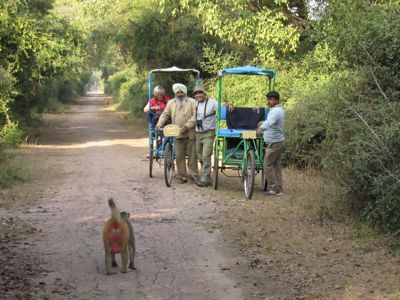 This male Rhesus Macaque had his eyes on Rosemary!
This male Rhesus Macaque had his eyes on Rosemary!
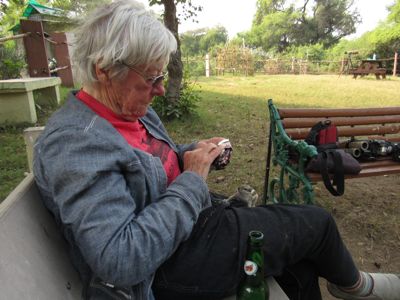 How many times has a Palm Squirrel been observed being fed by a Fox?!
How many times has a Palm Squirrel been observed being fed by a Fox?!
But more impressive still were the Indian Rock Pythons that we encountered. Our first was unexpected; Bablu and I were on foot in an area unsuitable for rickshaws, and a large stick on the track ahead of us suddenly moved, revealing a large and bulky Python, edging its way slowly towards us. We remained still while it gradually turned towards a sunny patch, where it eventually settled down to bask in the last rays of the afternoon sun. It was amazing to watch its ribs moving in a wave motion under its glistening skin; unlike other snakes, pythons move straight along rather than twisting, making them look purposeful and determined.
 Our first view of the Rock Python as it started to cross the track
Our first view of the Rock Python as it started to cross the track
 The Python then settled down to enjoy the last afternoon rays of sunshine
The Python then settled down to enjoy the last afternoon rays of sunshine
 How snakes manage with no eyelids is hard to imagine
How snakes manage with no eyelids is hard to imagine
Once we had edged our way past the snake, which was fully aware of our presence but did not seem concerned, we were able to admire the perfect tracks it had left in the sand, its weight having created what looked like highways in the dirt. Its hole was just by the track too, and we could see precisely which routes it had taken on its recent excursions.
 The Python's trail could clearly be seen
The Python's trail could clearly be seen
Although pythons do not seem to be directly persecuted in the park, they are nonetheless sensitive to undue disturbance, and the following day when we returned to try to show the snake to Rosemary we were again to witness some inconsiderate behaviour by photographers. We relocated the python and observed it quietly through my telescope, but it was not long before a group of loud and brash photographers arrived, crashing their way down the side of the roadway and approaching the basking snake extremely closely from the other side. Not wishing to witness another case of animal harassment for the sake of a better photograph, we left the area. One evening, Rosemary, Bablu and I took a short boat trip, which allowed us to view one section of the park from a different perspective, as we quietly drifted along a channel before heading into the flooded forest, at times literally gliding over the submerged aquatic vegetation. The highlight of this tour was a beautifully camouflaged Indian Nightjar, which we would never have seen if our boatman had not known precisely on which branch it regularly roosted. Knowing the roosting sites of nightjars and owls is one of the key advantages that local guides can bring.
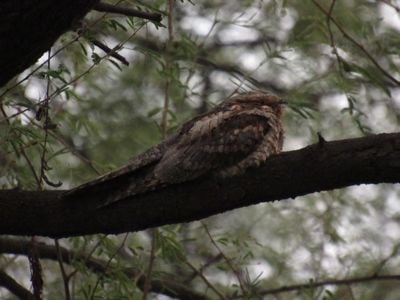 The Indian Nightjar was peacefully roosting on its branch
The Indian Nightjar was peacefully roosting on its branch
However, despite having astonishing local knowledge, Bablu's efforts to find one of my main targets, the Spotted Creeper, came to nothing. I had long wanted to see this strange-looking bird, which is restricted to the drier forest areas of Central India, and which used to be relatively easy to locate in the acacia woodland of certain areas of the park. But try as we might, the Creeper was nowhere to be seen. Bablu suggested that the recent increase in numbers of Rhesus Macaques could be responsible, as another hole-nesting bird, the Chestnut-bellied Nuthatch, has also recently disappeared. It could be that the monkeys are raiding the nests of these birds.
 Former Creeper habitat - where have they gone?
Former Creeper habitat - where have they gone?
 A Spotted Creeper photographed at Thal Chappar by a friend of Sumantha Ghosh
A Spotted Creeper photographed at Thal Chappar by a friend of Sumantha Ghosh
Even without the Creeper, however, and minus its Siberian Cranes, Bharatpur is a magical place, and one to which I shall certainly return. Our thanks go to Bablu for his excellent guiding, to Harish and Mr Singh for pedalling us around the park so valiantly, and to Sumantha Ghosh of Rural Traveller for organising the logistics behind our stay. We did venture out of the park on one of the days, to the Chambal River, but that was so exciting that it warrants its own blog post, which will appear soon.
 Our entire Bharatpur team: Harish, Bablu, Rosemary, Sumantha, Raju Singh and self
Our entire Bharatpur team: Harish, Bablu, Rosemary, Sumantha, Raju Singh and self



